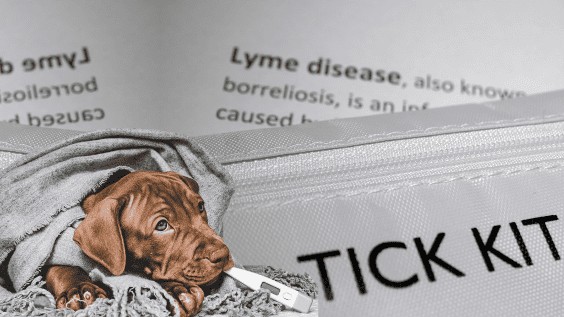Lyme Disease in Dogs and Pets [Symptoms, Tests, Prevention]

Updated 3/17/2025
Lyme disease is a tick-borne illness that dog owners should be aware of, especially in areas where ticks are common. Caused by the bacteria Borrelia burgdorferi, it can affect dogs’ health, but with the right knowledge and preventive care, the risks can be managed. Understanding the signs, prevention strategies, and available treatments can help keep your pup healthy and active.
How Lyme Disease Spreads
Lyme disease is transmitted through the bite of infected ticks, specifically the black-legged tick (also known as the deer tick). These tiny pests pick up the bacteria from infected wildlife, such as mice and deer, and pass it on when they latch onto a dog.
Here’s how the transmission works:
- A tick attaches to your dog, usually in areas with thin fur (like the ears, belly, or between the toes).
- The tick feeds on your dog’s blood over several hours to days.
- The tick carrying Borrelia burgdorferi can pass the bacteria into your dog’s bloodstream.
Not every tick carries Lyme disease, and not every bite results in infection. However, the longer a tick is attached, the higher the risk—so regular tick checks and prompt removal are key!

Recognizing the Signs of Lyme Disease in Dogs
Lyme disease can be tricky to spot because symptoms don’t always appear immediately. Some dogs may not show any symptoms at all, while others develop noticeable health issues. Here are some common signs to watch for:
- Lameness and joint pain – Your dog may limp or seem stiff, and the lameness can shift from one leg to another.
- Fever – A persistent fever (103°F–105°F) could indicate infection.
- Lethargy – Your normally energetic pup might seem unusually tired.
- Loss of appetite – A sudden disinterest in food is often a red flag.
- Swollen lymph nodes – Lumps around the neck or legs may indicate an immune response.
- Stiff gait – Your dog might move more slowly or seem uncomfortable, especially after resting.
- Behavioral changes – Increased irritability or signs of depression could mean something’s off.
- Breathing issues – In rare cases, dogs can develop breathing difficulties.
- Kidney problems – Advanced Lyme disease can lead to kidney disease, which may cause increased thirst and urination.
If your dog shows any of these symptoms, scheduling a vet visit right away is important. Early detection makes treatment much more effective!
Is There a Telltale Sign? The Bullseye Rash
In humans, a bullseye-shaped rash is a common indicator of Lyme disease. However, this rash is much less common in dogs and often goes unnoticed due to their fur. Instead, pet parents should focus on other symptoms and be proactive about checking for ticks.
The Stages of Lyme Disease
Lyme disease progresses in three stages, each with different symptoms:
- Early Localized Infection (3–30 days after a tick bite)
- Mild fever
- Lethargy
- Swollen lymph nodes
- Loss of appetite
- Early Disseminated Infection (weeks to months later)
- Intermittent joint pain or limping
- Swollen joints
- Fatigue
- Enlarged lymph nodes
- Late Persistent Infection (months to years later, if untreated)
- Chronic arthritis
- Kidney damage or failure
- Heart problems
- Neurological issues (seizures, paralysis)
How Lyme Disease is Diagnosed
Diagnosing Lyme disease involves more than just spotting symptoms. Vets use a combination of tests to confirm infection:
- Physical exam – Checking for signs like joint swelling and fever.
- Medical history – Assessing potential tick exposure.
- Blood tests – Detecting antibodies against Borrelia burgdorferi.
- Urinalysis – Identifying potential kidney damage.
- Joint fluid analysis – If arthritis is suspected, joint fluid may be tested.
How Is Lyme Disease Treated?
As stated by Malcolm Weir, DVM, MSc, MPH; Ryan Llera, BSc, DVM; and Ernest Ward, DVM, in the VCA hospital article: “Because the Lyme spirochete is a bacterium, it can be treated with antibiotics. The antibiotic of choice is doxycycline (Doxirobe®, Vibramycin®), followed by amoxicillin (Amoxi-Tabs®, Amoxi-Drop®, Biomox®), then azithromycin (Zithromax®). Treatment lasts for four weeks. Occasionally, the initial infection will recur, or the pet will become re-infected by being bitten by another infected tick.”
Protecting Your Dog from Lyme Disease
Prevention is always better than treatment! Here are some simple steps you can take to protect your pup:
- Use a veterinary-approved flea and tick prevention treatment to protect your dog from pests. Speak with your veterinarian to find the best product for your pet’s needs and ensure they stay healthy and comfortable.
- Check for ticks daily – Especially after walks in grassy or wooded areas. Pay close attention to the ears, neck, armpits, and between the toes.
- Remove ticks properly – Use tweezers or a tick removal tool to grab the tick close to the skin and pull it straight out. Ensure you are removing ticks properly by following these methods.
- Avoid tick-infested areas – Stick to trails and avoid tall grass or dense underbrush.
- Vaccinate your dog – There’s a Lyme disease vaccine available for dogs at risk—ask your vet if it’s right for your pup.
How Can Pet Insurance Help You if Your Dog Needs a Treatment?
Pet insurance can be a valuable tool in managing the costs of treating a dog’s veterinary expenses. By having a pet insurance policy in place, you can have peace of mind knowing that you can provide medical care for your furry companion without worrying about the financial burden. Pet insurance can help cover the costs of veterinary consultations, diagnostic tests, medications, and even specialized treatments if required.
Reimbursement
This method is the most common for pet insurance companies. You pay out of pocket for the veterinarian bill, and then the insurance company reimburses you for what’s covered under the insurance plan. The steps look like this.
- You pay the vet bill after your dog’s visit.
- You fill out the pet insurance claim form.
- Submit the claim form and other required documentation to the insurer.
- After the claim is approved, you will be reimbursed for eligible expenses.
What Does Odie Pet Insurance Cover?
Pet insurance covers various veterinary expenses, providing financial protection and peace of mind for pet owners. Here are the details of the coverage options offered by Odie Pet Insurance:
Illness & Injury Plan
The Illness & Injury Plan is an all-inclusive insurance plan designed to cover a wide range of medical needs for your pet. This plan includes comprehensive coverage for various illnesses, injuries, and veterinary services. Some of the covered items include:
- Veterinary exams and consultations
- Diagnostics (e.g., X-rays, lab tests)
- Prescribed medications
- Surgeries and hospitalization
- Rehabilitation, acupuncture, or chiropractic treatments
- Medically necessary supplies
- Euthanasia and cremation
The Wellness Plan
The Wellness Plan is a monthly membership that focuses on preventive care and covers routine veterinary services.
- Provides reimbursements for routine care items such as wellness visits (exams and vaccines), testing and parasite prevention, dental cleanings and at-home dental care, vitamins, supplements, and more
- Through Odie’s partnership with Petivity, a leader in smart pet products and proactive care, Wellness Plan members can also receive reimbursements for Petivity devices and health kits, as well as eligible Purina food and supplements.
- Total reimbursement up to $700 per year.



